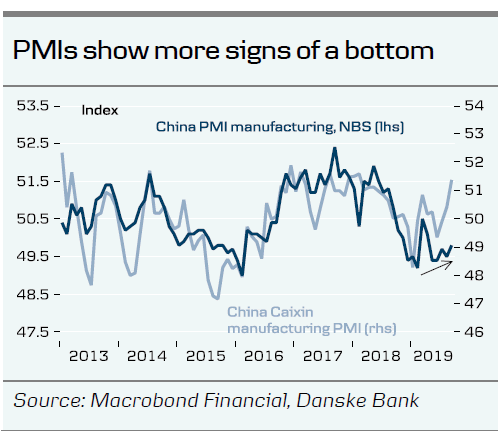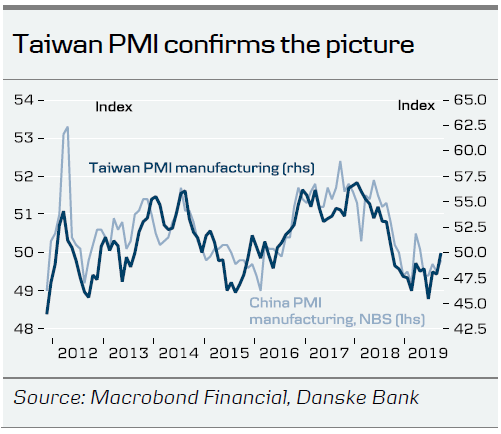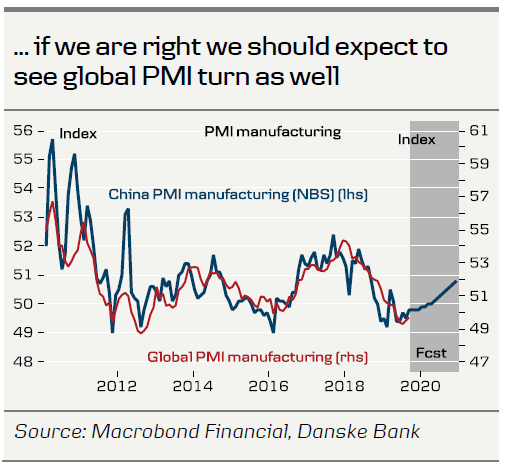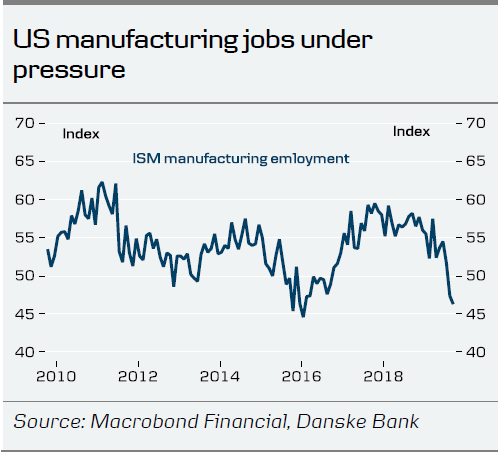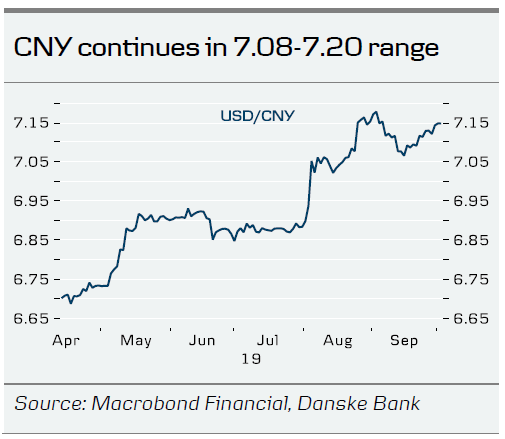- Chinese data suggest the worst is behind us in Chinese manufacturing.
- We see 60% probability of an interim deal next week. Weak US data and impeachment headwinds put pressure on Donald Trump, which increases the chances he might compromise to get a bigger deal next year.
- The 70-year anniversary of the People’s Republic of China (PRC) cemented China’s rise economically and militarily.
Signs of a bottom in the Chinese cycle
Monday morning was unusually cheerful this week, at least on the economic front in China. PMI manufacturing once again surprised on the upside and increasingly points to a bottom in the Chinese business cycle. In particular, the private version of PMI from Caixin was strong, as it climbed to the strongest level since early 2018 when the economy was quite robust. The official version from NBS paints a less upbeat picture but it is still moving gradually away from the low point in February. It is always good to cross-check Chinese data with numbers in the region around China but here we also see an image of tentative light shining through the darkness. For example, Taiwan PMI for September moved to the highest level since September.
If we turn to another of our favourite indicators of Chinese activity, metal prices, the same picture emerges. The top chart overleaf shows that metal price inflation fits well with the picture of moderate improvement. Indicators such as electricity generation and rail freight have also seen a lift in recent months, adding weight to the story. Finally, M1 growth has moved away from the weak readings around zero to above 3% y/y.
Comment: The improvement is coming a bit earlier than we expected but it is showing up in some of the places we regard as reliable based on historical experience. As China often leads the global business cycle and the country has been the epicentre of the global slowdown, this could be the first early sign of a bottom in the manufacturing cycle in early 2020. This has historically been supportive for global equities.
If you are a company, it is important to stress that the numbers are not great. They are just not as bad as they were at the beginning of the year. However, they offer a ray of light and at least it should be comforting that a hard landing does not seem to be on the cards. However, the development depends on what happens in the trade war but we doubt Trump will dare to escalate much further from here and he could still opt for a deal at some point.
We believe the improvement in China is related to (1) the effect of stimulus giving a lift to infrastructure and consumers, (2) residential construction still being robust due to low inventories and decent demand and (3) an inventory cycle in companies that may have run its course. We look for NBS manufacturing PMI to move sideways in the short term before recovering further in 2020 as stimulus kicks in further and we do not expect a further escalation in the trade war.
Trade talks coming up with decent chance of interim deal
Next week, the US and China are set to face off again in a new round of high-level trade talks in Washington. There has been limited news from China, as all focus has been on celebrating the anniversary of the PRC. In the US, stories broke that the White House is looking into the possibility of delisting Chinese companies from US stock exchanges and restricting US investments in Chinese assets. It sent a few shockwaves through financial markets but Trump’s trade adviser Peter Navarro called it ‘fake news’. A sharp decline in the ISM manufacturing index was a sign that the trade war is taking its toll on US manufacturers. The sector that Trump vowed would get stronger because of the trade war and to which jobs would return is instead hurting. The employment index in the report fell to 46.3, indicating that manufacturing jobs are declining again.
Comment: We believe both sides would like to strike an interim deal (see US-China Trade – 60% probability of interim deal, 2 October). According to some sources, the White House is concerned about the damage to the US economy and it would like to find a way out of raising tariffs further. China would also like to see a de-escalation of the trade war to move further away from the brink of total economic war and an interim deal could achieve just that. See above for more details.
We still believe there are big hurdles to leap to strike a big deal. China has indicated it cannot move much further than where it ended in May. The uncertainty is whether Trump could feel pressured into taking what is on the table at some point if he faces too much headwind on other fronts. Winning the election next year could be difficult with a cooling economy and a possible impeachment process on top of farmers and manufacturing workers hurt by a trade war. Our baseline is still no-deal ahead of the election but the pendulum is swinging more towards a deal at some point if Trump’s headwinds continue.
China’s 70-year anniversary celebrations send a strong signal
Celebrations on 1 October were a demonstration of strength in both economic and military terms. At the Gate of the Heavenly Palace, President Xi Jinping stated that ‘No force can ever shake the status of China, or stop the Chinese people and nation from marching forward’. A long military parade showed new military equipment for the first time.
Comment: Foreign powers ran over China during what is called the ‘century of humiliation’ from 1840 to 1949 and China has sent a strong signal that it will never allow this again. Chinese leaders also used the anniversary to celebrate the economic rise and to appeal to a common project of continuing the rejuvenation and achieving the Chinese Dream.
Other China news this week
Hong Kong protests ran high this week and police shot a teenager. The Hong Kong government is set to announce a new law banning masks during public assemblies.
China tech news of the week
- Patriotism-themed game from Tencent tops charts ahead of the 70-year anniversary.
- Chinese car start-up evades Trump tariffs with AI and 3D printing. It sells data to produce the car components through 3D printing in the US – brave new world.
- Chinese venture capital in the US falls to four-year low following US restrictions. Venture capital funds turn instead to India and the rest of Asia.




